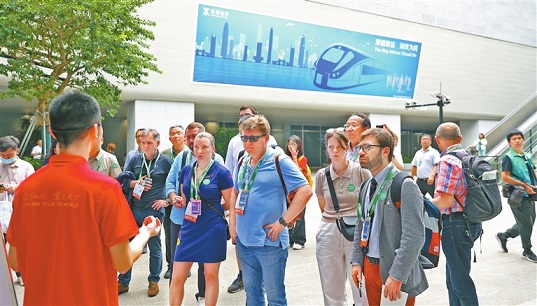Shenzhen
 2024/5/1
2024/5/1
 source: Shenzhen Daily
source: Shenzhen Daily
 Print
Print

Attendees of the World Tunnel Congress visit Huangmugang Transport Hub on April 24. Courtesy of Shenzhen Metro Group

Passengers wait in lines while shopping at the business area of the Eye of Shenzhen yesterday.Courtesy of Shenzhen Metro Group
Han Ximin
1824295095@qq.com
THE 2024 World Tunnel Congress concluded in Shenzhen on April 25, demonstrating the world’s significant breakthroughs and developmental milestones in tunnel excavation technology and practice over the past five decades.
During the four-day conference that attracted 2,700 professionals from the industry worldwide, participants had a chance to learn about key tunnel projects through field visits to the Shenzhen-Zhongshan Link, the Huangmugang Transport Hub, the Qianhai-Huanggang section of the Guangzhou-Dongguan-Shenzhen Intercity Rail, and the Qianhai International Hub Center project.
During the congress, the organizer, the International Tunneling and Underground Space Association (ITA), showcased 50 iconic tunnel and underground space projects that have taken place over the past 50 years. Among these projects is Metro Line 14, the only Chinese metro project included on the list.
Metro Line 14, 50.32 kilometers long, links Pingshan and the Futian CBD and cuts the travel time between the two districts to 40 minutes. Along the route, three transport hubs — the Gangxia North Transport Hub, the Universiade Transport Hub, and the Huangmugang Transport Hub — stand out for their engineering feats, environment protection technologies, and quick transit services.
City of tracks
At the tunnel congress, Shenzhen Mayor Qin Weizhong stated that Shenzhen, a mega-city with ultra-high density and massive flow, has formed a metro network spanning 567 kilometers to date, ranking it first in China in terms of density.
In Shenzhen, developing underground spaces and enhancing connections between aboveground and underground spaces is crucial to resolving the land bottleneck and improving the efficiency of land use.
From Futian Station, the largest underground railway station in Asia, to the Bay Book Store in Qinahai, the largest book store facility in China — which will be completed before the end of 2024 — Shenzhen continues to build underground spaces to meet its unique urban development needs.
The Bay Book Store project, with a floor space of 131,000 square meters, is connected with Line 5’s Baohua Station and will open in 2025. The underground space is about 96,000 square meters, three times the space above ground. Through eight exits, the underground spaces are connected to the metro station and nearby office buildings. Furthermore, the rooftop of the project is a park, according to project director Zhang Tao.
Underground development
With the May Day holiday approaching, the Eye of Shenzhen Shopping Center at the Gangxia North Station will initiate a two-month-long sports season in its outer square, presenting trendy sports events and a coffee festival to visitors. The business area of the Eye of Shenzhen, which opened to the public recently, will hold carnivals and creative product markets for passengers.
“Taking a metro ride is not simply going from A to B. Commuters will have more places to eat, have fun, or even enjoy a movie along the way,” said Li Gang, chairman of Shenzhen Metro Commercial Management Co. Ltd.
When the southern section of Line 13 opens later this year, the stations along the route, like Keyuan, Yuehaimen, Shenzhen University, and Hi-Tech Central stations, will provide more spaces for commercial development.
Based on the composition of the neighborhoods near each station — residential areas, office areas, and transport centers — the Shenzhen Metro Group will build or develop different types of facilities and invite different types of businesses to move in to meet the demands of each neighborhood, according to Li.
The Shenzhen Municipal Planning and Natural Resources Bureau outlined the city’s underground space development in 45 key areas across the city between 2020 and 2035.
By 2035, the city aims to become a model for the efficient, high-quality, systematic, and sustainable use of underground resources.
The key areas for underground development include the Shenzhen Park of the Hetao Shenzhen-Hong Kong Science and Technology Innovation Cooperation Zone, the Shenzhen Bay Super Headquarters Base, the Bao’an CBD, the Shenzhen Airport Hub, the Shenzhen North Station Transport Hub, the Guangming Science City Transport Hub, the Shenzhen East Station Hub, the Meilin Checkpoint Hub, the Longgang Universiade Transport Hub, the Longcheng Square Hub, and the Pingshan Station Transport Hub.





